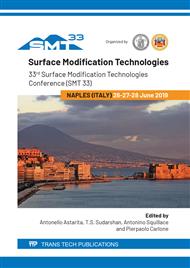[1]
S. Rossi, M. Calovi, D. Velez, J. Munoz, Influence of addition of hard particles on the mechanical and chemical behavior of vitreous enamel, Surf. Coat. Techol. 357 (2019) 69-77.
DOI: 10.1016/j.surfcoat.2018.09.062
Google Scholar
[2]
S.T. Reis, M. Koenigstein, L. Fan, G. Chen, L. Pavić, A. Moguš-Milanković, The effects of silica on the properties of vitreous enamels, Materials. 12 (2019) 248.
DOI: 10.3390/ma12020248
Google Scholar
[3]
K. Hrabovská et al., Effect of fine clay fraction on functional properties of vitreous enamel coatings, Chem. Listy. 106, (2012) s432-s433.
Google Scholar
[4]
S. Rossi, M. Fedel, F. Deflorian, N. Parziani, Abrasion and chemical resistance of composite vitreous enamel coatings with hard particles, Surf. Interface Anal. 48 (2016) 827-837.
DOI: 10.1002/sia.5849
Google Scholar
[5]
S. Rossi, C. Zanella, R. Sommerhuber, Influence of mill additives on vitreous enamel properties, Mater. Des. 55 (214) 880-887.
DOI: 10.1016/j.matdes.2013.10.059
Google Scholar
[6]
S. Rossi, L. Bergamo, V. Fontanari, Fire resistance and mechanical properties of enamelled aluminium foam, Mater. Des. 132 (2017) 129-137.
DOI: 10.1016/j.matdes.2017.06.064
Google Scholar
[7]
Md J. Nine, Martin A. Cole, D. N. H. Tran, D. Losic, Graphene: a multipurpose material for protective coatings J. Mater. Chem. A, 24 (2015) 12580–12602.
DOI: 10.1039/c5ta01010a
Google Scholar
[8]
P. Haghdadeh, M. Ghaffari, B. Ramezanzadeh, G. Bahlakeh, M. R. Saeb, The role of functionalized graphene oxide on the mechanical and anti-corrosion properties of polyurethane coating, J. Taiwan. Inst. Chem. E. 86 (2018) 199-212.
DOI: 10.1016/j.jtice.2018.02.009
Google Scholar
[9]
S. Arora, C. Srivastava, Microstructure and corrosion properties of NiCo-graphene oxide composite coatings, Thin. Solid. Film. 677 (2019) 45 -54.
DOI: 10.1016/j.tsf.2019.03.011
Google Scholar
[10]
G. Yasin et al., Synthesis of spheres-like Ni/graphene nanocomposite as an efficient anti-corrosive coating; effect of graphene content on its morphology and mechanical properties, J. Alloy. Compd. 33 (2018) 79-88.
DOI: 10.1016/j.jallcom.2018.04.321
Google Scholar
[11]
X. Zhang et al., Corrosion resistance of organic coating based on polyhedral oligomeric silsesquioxane-functionalized graphene oxide, Appl. Surf. Sci. 484 (2019) 814–824.
DOI: 10.1016/j.apsusc.2019.04.158
Google Scholar
[12]
A. Sanjid, P. C. Banerjee, R.K. Singh Raman, Multi-layer graphene coating for corrosion resistance of Monel 400 alloy in chloride environment, Surf. Coat. Tech. 370 (2019) 227–234.
DOI: 10.1016/j.surfcoat.2019.04.077
Google Scholar
[13]
G. Cui, Z. Bi, R. Zhang, J. Liu, X. Yu, Z. Li, A comprehensive review on graphene-based anti-corrosive coatings, Chem. Eng. J. 373 (2019) 104–121.
DOI: 10.1016/j.cej.2019.05.034
Google Scholar
[14]
S. Saadatmandi, M. Asghari, B. Ramezanzadeh, Effective epoxy composite coating mechanical/fracture toughness properties improvement by incorporation of graphene oxide nano-platforms reduced by a green/biocompataible reductant, J. Ind. Eng. Chem. 75 (2019) 271–284.
DOI: 10.1016/j.jiec.2019.03.038
Google Scholar
[15]
X. Wang, J. Zhao, E. Cui, S. Song, H. Liu, W. Song, Microstructure, mechanical properties and toughening mechanisms of graphene reinforced Al2O3-WC-TiC composite ceramic tool material, Ceram. Int. 45 (2019) 10321–10329.
DOI: 10.1016/j.ceramint.2019.02.087
Google Scholar
[16]
R. Umer, Manufacturing and mechanical properties of graphene coated glass fabric and epoxy Composites, J. Compos. Sci. 2 (2018) 17.
DOI: 10.3390/jcs2020017
Google Scholar


